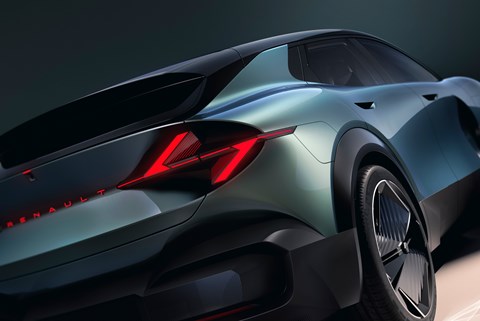► Renault division Ampere rethinking EVs
► Renault Emblème a fuel cell/EV hybrid
► Produces 90% less carbon over lifetime
Renault’s EV specialist division Ampere has outlined a strategy to significantly decarbonise Renault Group vehicles, manifested in the Renault Emblème concept car.
Ampere, Renault’s technology-driven sub brand spearheading the development and production of Renault’s EV programme, is taking a holistic approach to decarbonisation, considering a car’s emissions across its entire lifespan, or ‘from the cradle to the grave.’
Ampere says this can be split into five phases: ‘eco-design’, the source of materials used in the manufacturing of vehicles, the manufacturing process itself, the car’s use and then its end-of-life care.

According to the marque, the Emblème is product of this tac. Ampere says the car would emit 90% less carbon across its lifespan compared to a comparable fossil fuel-powered car built today.
‘Emblème embodies our ecosystem approach and the level of our ambition when it comes to building a sustainable future through technological innovation,’ says Luca De Meo, Renault Group and Ampere CEO
‘It embodies the future Design Language of the Renault brand. An average ICE car has a 50 tons footprint: for Emblème, it’s 5 tons, cradle to grave. It’s a masterpiece.’
How does the Emblème save so much carbon?
Let’s start with the materials. Since almost all of the carbon produced by material extraction comes from just a handful of primary culprits – chiefly steel, aluminium and polymers – Ampere has drawn on the expertise of an eclectic partner pool to optimise its selection of raw materials and lower its carbon footprint at purchasing.

The Emblème is built from low-carbon steel, low-carbaluminium and plastics to reduce its carbon footprint, while the battery comprises of sustainably extracted nickel and sulphate, among other materials.
As for power train, the Emblème utilises a dual energy system for its 160kw electric motor, drawing power from a 40 kWh battery as well as a hydrogen fuel cell. Ampere is investing – and banking – heavily on the future of hydrogen fuel, though as an axillary power supply to work in tandem with a conventional battery.
On shorter journeys, the Emblème would carry out its duties like any other EV, but with a longer journey ahead, could rely on the longevity of hydrogen power to fuel the car while avoiding any long charging periods.
According to Ampere, the Emblème should be able to cover over 620 miles in the same time period as an ICE-powered car, with only two five minute stops required to refuel to hydrogen cell.
Where would you get the hydrogen fuel from? Well, Ampere reckons that the adoption of hydrogen fuel use in trucks will eventually necessitate the development of at least some refuelling structure, even if it only exists on the motorway. Whether that transpires, remains to be seen.
Just a 40 kWh battery?
Yes, by increasing the efficiency of its batteries, Ampere has been able to reduce their size without compromising too much on output. As a result of the downsize, though, the batteries are also considerably lighter.

A conventional 87kWh battery might weigh as much as 513 kilograms, but the 40 kWh battery in the Emblème weighs only 291 kilos, contributing to an overall vehicle weight of just 1,800 kilograms for a further reduction in carbon emissions.
Finally the end of life care. Ampere says the Embleme has been crafted so that almost the entire car can be recycled at the end of its lifespan. Many of the body’s fundamental materials, including the steel, aluminium and plastics, are fully recyclable.
What does the future hold?
It’s unlikely that the Emblème will go into production – though nothing should be entirely discounted – but Ampere has put together a schedule of when certain technologies may start to be mass produced.
For example, by 2026 the marque wants to lower battery costs by 20% through a transition to Lithium iron phosphate (LFP) batteries from Nickel Manganese Cobalt (NMC).

Historically LFP haven’t had the energy density to be be used viably, but owing to a rebalance of the chemistry, including a switch from graphite to silicon anodes (getting techy now), LFP batteries can be just as energy dense as MNC yet still remain cheap and safe as.
By 2028, Ampere wants to go completely cobalt free, which it expects to create a 50% reduction in battery costs compared to today.
By 2026, Ampere also has plans to launch the first ever software-defined vehicle – a car that features a centralised computer architecture, capable of receiving over the air updates so the vehicle can evolve over its lifetime.
If an SDF sounds like a smartphone on wheels, it pretty much is, and it’s telling that of Ampere’s 11,000 employees, 35% are engineers while 50% are software developers. According to Renault’s vision of the future, software will become the fundamental essence of a car’s makeup.